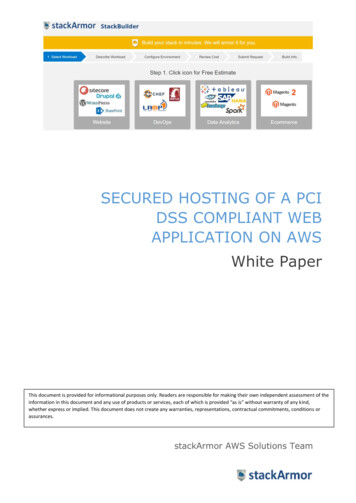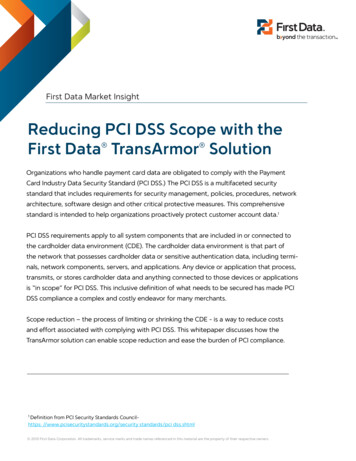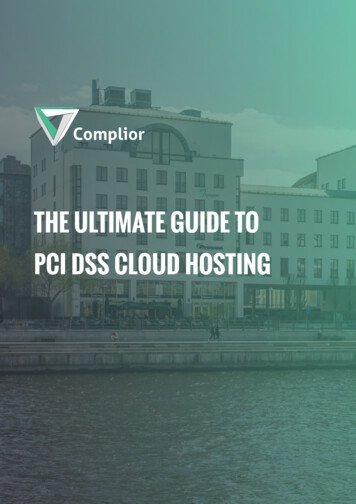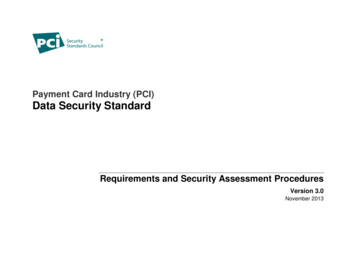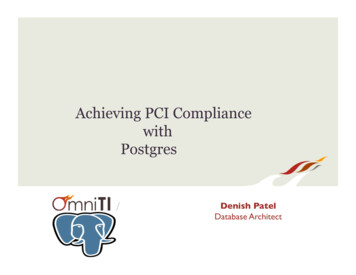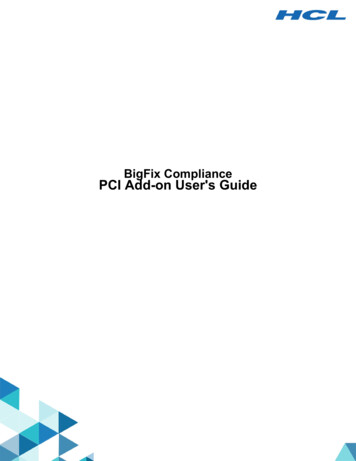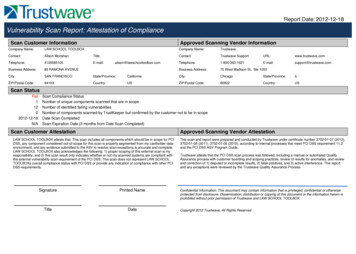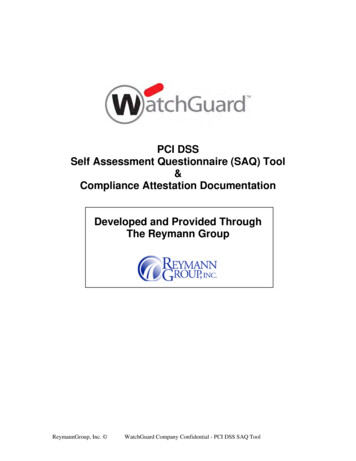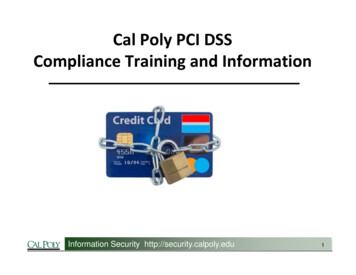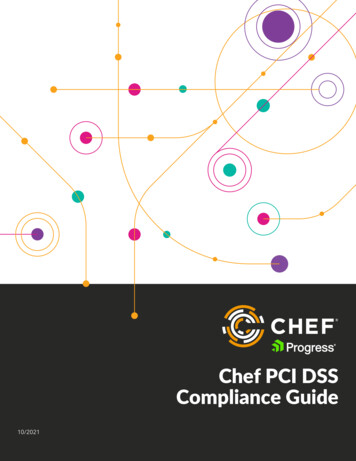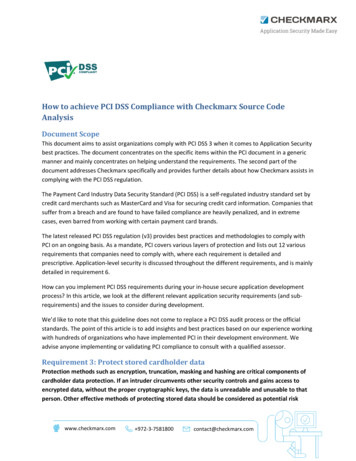
Transcription
How to achieve PCI DSS Compliance with Checkmarx Source CodeAnalysisDocument ScopeThis document aims to assist organizations comply with PCI DSS 3 when it comes to Application Securitybest practices. The document concentrates on the specific items within the PCI document in a genericmanner and mainly concentrates on helping understand the requirements. The second part of thedocument addresses Checkmarx specifically and provides further details about how Checkmarx assists incomplying with the PCI DSS regulation.The Payment Card Industry Data Security Standard (PCI DSS) is a self-regulated industry standard set bycredit card merchants such as MasterCard and Visa for securing credit card information. Companies thatsuffer from a breach and are found to have failed compliance are heavily penalized, and in extremecases, even barred from working with certain payment card brands.The latest released PCI DSS regulation (v3) provides best practices and methodologies to comply withPCI on an ongoing basis. As a mandate, PCI covers various layers of protection and lists out 12 variousrequirements that companies need to comply with, where each requirement is detailed andprescriptive. Application-level security is discussed throughout the different requirements, and is mainlydetailed in requirement 6.How can you implement PCI DSS requirements during your in-house secure application developmentprocess? In this article, we look at the different relevant application security requirements (and subrequirements) and the issues to consider during development.We’d like to note that this guideline does not come to replace a PCI DSS audit process or the officialstandards. The point of this article is to add insights and best practices based on our experience workingwith hundreds of organizations who have implemented PCI in their development environment. Weadvise anyone implementing or validating PCI compliance to consult with a qualified assessor.Requirement 3: Protect stored cardholder dataProtection methods such as encryption, truncation, masking and hashing are critical components ofcardholder data protection. If an intruder circumvents other security controls and gains access toencrypted data, without the proper cryptographic keys, the data is unreadable and unusable to thatperson. Other effective methods of protecting stored data should be considered as potential riskwww.checkmarx.com 972-3-7581800contact@checkmarx.com
mitigation opportunities. For example, methods for minimizing risk include not storing cardholderdata unless absolutely necessary, truncating cardholder data if full Primary Account Number (PAN) isnot needed, and not sending unprotected PANs using end-user messaging technologies, such as e-mailand instant messaging.This requirement lays out the storage guidelines for sensitive credit card information. In particularsubsection 3.4 specifies that PAN data must be rendered unreadable. This can already be performedduring the application development stage by ensuring that sensitive data inserted into the database fitsthe set of requirements such as encryption. To implement, create different tests on your code which actas verifiers to the structure of the inputted data.Requirement 6: Develop and Maintain Secure Systems and ApplicationsUnscrupulous individuals use security vulnerabilities to gain privileged access to systems. Many ofthese vulnerabilities are fixed by vendor-provided security patches, which must be installed by theentities that manage the systems. All critical systems must have all appropriate software patches toprotect against exploitation and compromise of cardholder data by malicious individuals andmalicious software.Note: Appropriate software patches are those patches that have been evaluated and testedsufficiently to determine that the patches do not conflict with existing security configurations. For inhouse developed applications, numerous vulnerabilities can be avoided by using standard systemdevelopment processes and secure coding techniques.The additional note (above) that PCI DSS provides is very important. As breaches of cardholder databecome more common, PCI recognized that most of these can be avoided by simple secure coding bestpractices. The good part is that requirement 6 really details out how a secure application developmentprogram should look like. We can easily adapt them to practice:PCI DSS RequirementsApplication Security: What to Look Out For6.1: Establish a process to identify securityvulnerabilities, using reputable outside sources forsecurity vulnerability information, and assign a riskranking (for example, as “high”, “medium”, “low”) tonewly discovered security vulnerabilities.The guidance for this subsection emphasizes the needfor a process that “actively monitors industry sources forvulnerability information”. But what about risk rankingyour own code – code that is affected by these newvulnerabilities, as well as in the unfortunate event thatas a vendor you release the vulnerability?Our suggestion: instead of risk ranking your code onlyaccording to the vulnerability’s severity, calculate therisk to also include the vulnerability’s prevalence in thecode. Why? If the vulnerability has, say, a medium-lowseverity but appears numerous times throughout thecode, then the attack surface through exploitation of thisparticular vulnerability increases.www.checkmarx.com 972-3-7581800contact@checkmarx.com
6.2: Ensure that all system components and softwareare protected from known vulnerabilities by installingapplicable vendor-supplied security patches. Installcritical security patches within one month of release.6.3: Develop internal and external softwareapplications (including web-based administrativeaccess to applications) securely as follows: In accordance with PCI DSS (for example,secure authentication and logging) Based on industry standards and/or bestpractices. Incorporating information securitythroughout the software developmentlifecycle.6.3.1: Remove development, test and/ orcustom application accounts, user IDs, andpasswords before applications become activeor are released to customers.Your development might be based on third-party code –whether through an API or even a Java framework.While reviewing your 3rd party-dependent code, payparticular attention that you are using thosecomponents that are up to date with their latest securityfixes.What happens if the review reveals that you are notusing numerous patches? In this case, follow the PCI DSSguidelines: use a risk-based approach to prioritize theupdates.Whether you are following a traditional SoftwareDevelopment Lifecycle (SDLC) process such as thewaterfall model or modern environments such as Agile,there are different industry standards and/ or bestpractices to incorporate security within your SDLCprogram. Rather than running application securityprocesses as a separate path to development,implementing the security process within the SDLCmakes the analysis simpler, more effective and easier toaddress when the need appears.Continuously perform specific tests on your source code- customized to your environment - to check theexistence of custom application accounts, user IDs andpasswords. In particular, be extra vigilant during the finalstages of product development for the appearance ofthis data.Prior to deployment, scan the application to validatethat all the custom application accounts, user IDs andpasswords are not hardcoded.www.checkmarx.com 972-3-7581800contact@checkmarx.com
6.3.2: Review custom code prior to release toproduction or customers in order to identifyany potential coding vulnerability (usingeither manual or automated processes) toinclude the following: Code changes are reviewed byindividuals other than the originatingcode author, and by individualsknowledgeable about code-reviewtechniques and secure codingpractices. Code reviews ensure code isdeveloped according to securecoding guidelines. Appropriate corrections areimplemented prior to release. Code-review results are reviewedand approved by management priorto release.Coding vulnerabilities are categorized into two: Technical vulnerabilitiesBusiness logic vulnerabilitiesBusiness logic vulnerabilities are code functionalitieswhich an attacker abuses to make the system work in anon-intended way. For example, a business logicvulnerability in a retail system may allow an attacker toinput a negative value as a purchase price in order toreceive funds back from the system.PCI DSS mainly emphasizes the technical vulnerabilitiesand further expands on these in requirement 6.5. This isnot to say that business logic vulnerabilities can beignored. On the contrary – as they do not follow thechecklist approach, you need to take extra care lookingout for them.To prevent BLAs, you should place tests customized toyour code. Going back to the negative input example,this means validating that the specific function does notreceive a negative value.PCI DSS further provides testing procedures to follow forthis requirement. While it is not our intention toduplicate the standard, we find it important enough tore-iterate PCI DSS’s testing procedures for thisrequirement: Examine written software-developmentprocedures and interview responsiblepersonnel to verify that all custom applicationcode changes must be reviewed (using eithermanual or automated processes) as follows:o Code changes are reviewed byindividuals other than the originatingcode author, and by individuals who areknowledgeable in code-reviewtechniques and secure coding practices.o Code reviews ensure code is developedaccording to secure coding guidelines(see PCI DSS Requirement 6.5).o Appropriate corrections areimplemented prior to release.o Code review results are reviewed andapproved by management prior torelease.www.checkmarx.com 972-3-7581800contact@checkmarx.com
6.4: Follow change control processes and proceduresfor all changes to system components. The processesmust include the following:In general, this requirement states that each changeneeds to be tracked – whether infrastructure or codemodification. Security should become an integral part ofthe change control process so that every time a systemcomponent changes, security tests are performed.6.4.1: Separate development/ testenvironments from productionenvironments, and enforce the separationwith access controls.6.4.3: Production data (live PANs) are notused for testing or development6.4.4: Removal of test data and accountsbefore production systems become activeIt is not enough to simply separate development andproduction environments. Separate security testingshould be done to each of these environments.6.4.5: Change control procedures for theimplementation of security patches andsoftware modifications must include thefollowing:While the below practices do not talk about tracking theprogress of application development throughout time,there is a lot of benefit to doing that as well - verifyingthe product’s security and compliance posture anddeveloper’s security awareness. Simply keep track ofprevious results and compare them to the new ones.Make documentation readable by producing them in theform of a dashboard or graphs for the security team orfor team leaders, and with finer-grained details to helpthe developer pinpoint the impact of the vulnerabilityDocumentation should not be reviewed only by thedeveloper. It should also be reviewed by the informationsecurity team and development leaders. Reviewingthese results together can lead to a better securityposture by recognizing those points that are problematicor repetitive code flaws.As in general coding best practices – test that what youadded not only does not break functionality but works asintended. The same goes for security: ensure that anycode change does not introduce new vulnerabilities,adversely impacts the security posture, or breaks PCIcompliance.Don’t throw away just yet your old code. You must havea procedure to revert to when needed to fall back.6.4.5.1: Documentation of impact.6.4.5.2: Documented change approval byauthorized parties.6.4.5.3: Functionality testing to verify thatthe change does not adversely impact thesecurity of the system.6.4.5.4: Back-out procedures.www.checkmarx.com 972-3-7581800This requirement can be implemented by scanning thetesting or development code for the existence of PANs.Achieve this requirement by scanning the productioncode for test data and accounts prior to deployment.contact@checkmarx.com
6.5: Address common coding vulnerabilities insoftware-development processes as follows: Train developers in secure coding techniques,including how to avoid common codingvulnerabilities, and understanding howsensitive data is handled in memory. Develop applications based on secure codingguidelines.This section lays out particular vulnerabilities to traindevelopers against and test against while developingcode.As specified, training is best done by helping developersunderstand how sensitive data is handled in memory. Infact, we found that it is not enough to simply show howan app is exploited. Rather, by actually presenting thecode flow (i.e. “behind the scenes” of the exploit) in avisualized manner aids the developer in becoming moresecurity-conscious.For each vulnerability below we demonstrate its riskthrough its impact. We leave it to the reader to follow upon secure coding practices and how to fix certainvulnerabilities.6.5.1: Injection flaws, particularly SQLInjection. Also consider OS CommandInjection, LDAP and XPath Injection flaws aswell as other injection flaws6.5.2: Buffer overflows6.5.3: Insecure cryptographic storage6.5.4: Insecure communications6.5.5: Improper error handling6.5.6: All “high risk” vulnerabilities identifiedin the vulnerability identification process (asdefined in PCI DSS Requirement 6.1).6.5.7: Cross-Site Scripting (XSS)www.checkmarx.com 972-3-7581800It is also important to note that although this PCI DSSsub-requirement discusses technical genericvulnerabilities, it is essential to recognize thatvulnerabilities exist within code flows based on thecustom code of each organization. These “custom”vulnerabilities may also be prevented through a secureSDLC program.The impact? Allows insecure code to execute on thebackend system. This can result in data theft,manipulation, corruption or the hosting of malware.The impact? Allows insecure code to execute on thebackend system. This can result in data theft,manipulation, corruption or the hosting of malware.The impact? Allows an attacker to decipher encrypteddataThe impact? Allows an attacker to eavesdrop, and evenintercept, communications.The impact? Leakage of information via error messagesThe impact? Attacker can relatively easy penetrate thesystem for their nefarious manners.To recall, we recommended a risk-ranking calculatedaccording to the vulnerability’s severity and prevalencein the code. Do not release code into production if any“High” rankings exist.The impact? Allows the running of a script on the client’smachine in order to bypass access controls.contact@checkmarx.com
6.5.8: Improper access control (such as insecuredirect object references, failure to restrict URLaccess, directory traversal, and failure to restrict useraccess to functions)6.5.9: Cross-site request forgery (CSRF)6.5.10: Broken authentication and sessionmanagement6.6: For public-facing web applications, address newthreats and vulnerabilities on an ongoing basis andensure these applications are protected againstknown attacks by either of the following methods: Reviewing public-facing web applications viamanual or automated applicationvulnerability security assessment tools ormethods, at least annually and after anychanges Installing an automated technical solutionthat detects and prevents web-based attacks(for example, a web- application firewall) infront of public-facing web applications, tocontinually check all traffic.The impact? Allows the crawling of the Web pages,uploading of a potentially malicious file to the server andaccessing restricted data.The impact? Allows the attacker to perform anapplication-level transaction on behalf of the victim.The impact? Allows the attacker to perform activities onbehalf of a legitimate user.In general, a web-based technical solution that detectsand prevents attacks only mitigates the risk of an attackuntil the code is fixed. A code review, on the other hand,actually fixes the issue. Ideally, you should perform both:review the code of your web application and use atechnical detection and prevention solutions (such as aRASP).If you have trouble conforming to both, consider theadvantages and disadvantages of each and howapplicable each solution is to your environment.In a manual code review, typically the auditor reviewsthe code to ensure it stands to a certain level of security.Most enterprises, however, find automated code reviewthrough scanning a much quicker, more effective andcost-reducing process which also provides greatercoverage. Whichever method you chose, ensure that thecode review is part of the secure SDLC and integrateswithin the development process in order to providequick fixes.Requirement 11.3: Implement a methodology for penetration testing thatincludes the following Defines application-layer penetration tests to include,at a minimum, the vulnerabilities listed in Requirement 6.5Requirement 11.3 discusses penetration testing for infrastructure and application security. As the pointof this article focuses on application security we refer to the application layer in this sub-requirement.Penetration testing may be done manually or automatically, and is usually performed as a combinationof both. Penetration testing may also be done in-house, by an individual (s) independent of the system,or by an external individual(s).Regardless of which methodology and practice you choose, makes sure you receive the results reportswww.checkmarx.com 972-3-7581800contact@checkmarx.com
with actionable remediation items. Set aside a timeframe to analyze the report, scheduling theremediation and re-testing your environment.How Checkmarx addresses the compliance requirements6.1 Establish a process to identify security vulnerabilitiesCheckmarx's CxSAST addresses thousands of vulnerabilities on the most prevalent coding languages.Detection is performed during the SDLC and is integrated as part of the development process.Vulnerabilities are all categorized and assigned with a severity level allowing the development andsecurity teams to easily prioritize and remediate the most important vulnerabilities basing the decisionnot only on the severity but also on the abundance of a specific vulnerability.6.2: Ensure that all system components and software are protected from knownvulnerabilities by installing applicable vendor-supplied security patches.Have your open source third parties scanned for vulnerabilities as part of your project. 3rd party codeembedded in your product can expose your application to multiple vulnerabilities. Checkmarx allowsmanual query creation which may be used to detect specific 3rd parties and there version number.In addition Checkmarx recommends enforcing Static code analysis on all included 3rd parties within theapplication. In case code is not accessible or the third party is not willing to share the code, Checkmarxrecommends asking the 3rd party to perform their own tests and deliver a full report of the results. Thiscan be performed using Checkmarx's on demand service mand/ .6.3: Develop internal and external software applications (including web-basedadministrative access to applications) securely as follows: Code changes are reviewed by individuals other than the originating code author, and by individualsknowledgeable about code-review techniques and secure coding practices. Code reviews ensure code is developed according to secure coding guidelines. Appropriate corrections are implemented prior to release. Code-review results are reviewed and approved by management prior to release.Checkmarx allows code analysis at every stage of the SDLC ensuring developers, testing teams, securitypersonnel and management are all in the loop of the application code's security status.Automated Reports containing detailed information about current security status and trend informationbased on previous scans (graphical and detailed data) are generated and emailed to the relevantpersonnel who are required to review the results. Out-of-the-box integration of Checkmarx with Buildservers, IDEs, Bug tracking tools and source repositories ensures the development teams follow securecoding guidelines and allow setting thresholds for approval of code release (no high risk vulnerabilitieswww.checkmarx.com 972-3-7581800contact@checkmarx.com
for example).6.4: Follow change control processes and procedures for all changes to system components.The processes must include the following:Checkmarx's CxSAST was designed to enable maintaining the developed code secure at all times.Incremental scanning allows the system to analyze only code which has been modified and not yetapproved. Incremental scanning ensures that whenever changes are performed on the code the systemdoes not waste time on analyzing the complete code base.6.4.1: Separate development/ test environments from production environments, andenforce the separation with access controls.Both testing and production environments should and can be tested separately generating separateresults.6.4.3: Production data (live PANs) are not used for testing or development6.4.4: Removal of test data and accounts before production systems become activeSimply instruct Checkmarx CxSAST to scan for existing PANs within the code on either the testing, thedevelopment and the production environment. Define the query with the relevant severity level andensure no PANs are present.6.4.5: Change control procedures for the implementation of security patches and softwaremodifications must include the following:6.4.5.1: Documentation of impact – Use Checkmarx's reports when presenting impact and trends ofmultiple scans. Present Dashboard or graphs for the security team or for team leaders, and with finergrained details to help the developer pinpoint the impact of the vulnerability.6.4.5.2: Documented change approval by authorized parties – Checkmarx allows automatedwww.checkmarx.com 972-3-7581800contact@checkmarx.com
sharing of analysis reports in multiple formats. Each scan can automatically generate a report to a predefined set of users. The reports can contain an executive summary or the full data and can bepresented in multiple formats.6.4.5.3: Functionality testing to verify that the change does not adversely impact the securityof the system – Checkmarx provides the user the ability to perform incremental scanning. Thisfunctionality is unique to Checkmarx and allows the user to re-scan only the parts of the code whichwere modified. This functionality reduces scanning time dramatically and ensures that changes do notintroduce new issues.6.4.5.4: Back-out procedures. – Checkmarx stores previously scanned code making sure it isaccessible in case changes need to be reverted. Checkmarx CxSAST also allows comparison of currentand previous scan results.6.5: Address common coding vulnerabilities in software-development processes as follows: Train developers in secure coding techniques, including how to avoid common codingvulnerabilities, and understanding how sensitive data is handled in memory. Develop applications based on secure coding guidelines.Checkmarx addresses secure coding practice and education as part of its product suite. As part ofCxSAST's code analysis presets we provide coverage for well-known regulations and for specific platformwww.checkmarx.com 972-3-7581800contact@checkmarx.com
requirements such as Mobile (Android or iOS). In addition Checkmarx's Game of Hacks is an interactivegame developed by Checkmarx to raise security awareness in the InfoSec community and helpdevelopers boost their secure coding skills. Besides being an interactive security resource that has beenplayed by over 80,000 players, Game of Hacks has also been developed as an educational platformwhich organizations implement within their environments to educate developers and share knowledgeacross the company. (www.gameofhacks.com)www.checkmarx.com 972-3-7581800contact@checkmarx.com
6.6: For public-facing web applications, address new threats and vulnerabilities on anongoing basis and ensure these applications are protected against known attacks by eitherof the following methods: Reviewing public-facing web applications via manual or automated application vulnerabilitysecurity assessment tools or methods, at least annually and after any changes Installing an automated technical solution that detects and prevents web-based attacks (forexample, a web- application firewall) in front of public-facing web applications, to continuallycheck all traffic.Checkmarx CxSAST fully integrates within the organizations SDLC allowing constant analysis of codewhether its new or previously written code. Rather than performing annual checks you can be on top ofyour code's security at any given time. Integrate CxSAST within the SDLC to enforce version release onlyonce the defined code security parameters have been enforced. Looking at the real time protectionaspect, Checkmarx also delivers CxRASP to protect applications from existing vulnerabilities in the codewhich are trying to be abused. CxRASP will be instrumented as part of the protected application so thatit can understand the data flow and ensure detection of relevant attacks only. Different from WAFsolutions CxRASP ensures low to zero false positives due to its understanding of the application flow.www.checkmarx.com 972-3-7581800contact@checkmarx.com
Requirement 3: Protect stored cardholder data Protection methods such as encryption, truncation, masking and hashing are critical components of cardholder data protection. If an intruder circumvents other security controls and gains access to encrypted data, without the proper cryptographic keys, the data is unreadable and unusable to that person.
